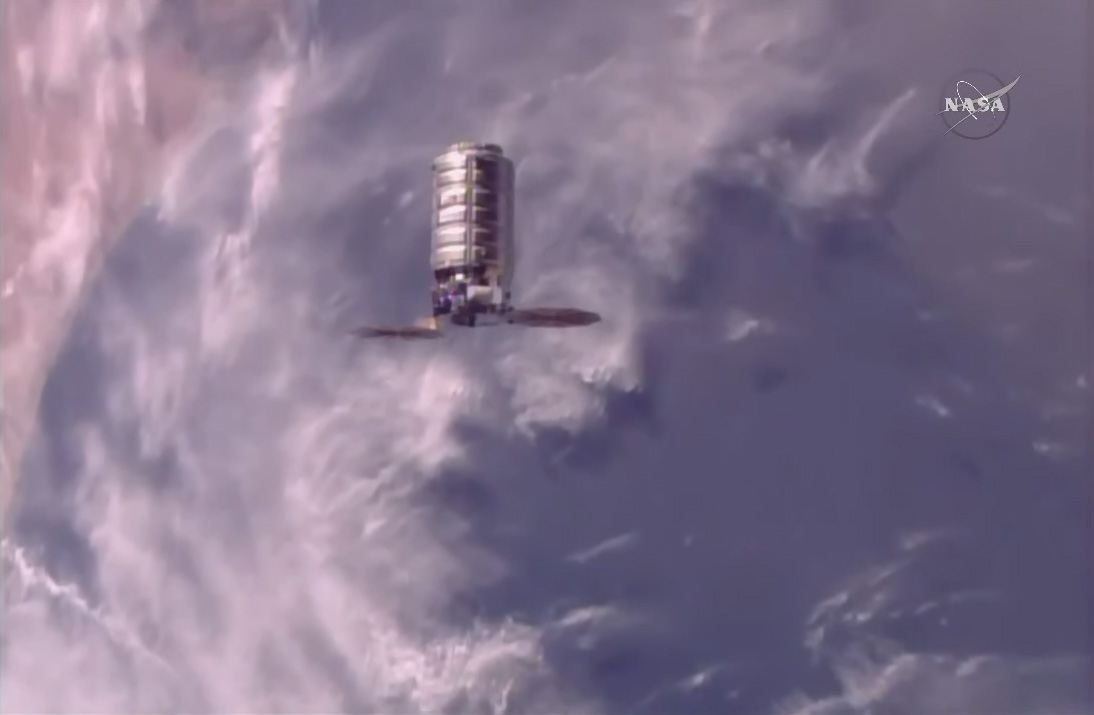Cygnus Cargo Ship Delivers Holiday Goodies and Science Gear to Space Station
A Cygnus cargo spacecraft arrived at the International Space Station (ISS) today (Nov. 14) to deliver food, supplies and some fascinating science experiments to the Expedition 53 astronauts.
Orbital ATK, a private spaceflight contracted by NASA to fly cargo to the ISS, named this Cygnus spacecraft the S.S. Gene Cernan in honor of the late NASA astronaut and last person to walk on the moon.
After launching from NASA's Wallops Flight Facility in Wallops Island, Virginia, on an Antares rocket Sunday (Nov. 12), Cygnus spent about 45 hours catching up to the ISS, which orbits about 250 miles (400 kilometers) above the Earth at a speed of about 17,500 mph (28,000 km/h). [In Photos: Orbital ATK's OA-8 Cygnus Cargo Launch to Space Station]

This was the shortest amount of time that a Cygnus spacecraft has spent flying to the ISS from liftoff to rendezvous, Frank DeMauro, vice president and general manager of Orbital ATK's Advanced Programs Division, said at a news conference at Wallops Flight Facility Saturday (Nov. 11).
Using Canadarm2, a 58-foot (18 meters) robotic arm outside the ISS, European Space Agency astronaut Paolo Nespoli and NASA astronaut Randy Bresnik grappled the incoming Cygnus cargo craft at 5:04 a.m. EST (1004 GMT), fourteen minutes behind NASA's original estimate of 4:50 a.m. EST (0950 GMT).
More than 7,700 lbs. (3,500 kilograms) of cargo launched to the ISS, including about 1,900 lbs. (860 kg) of science experiments and new technology demonstrations. The spacecraft also brought along some holiday goodies for the Expedition 53 crew, including their Thanksgiving dinner and gifts from the astronauts' families, Orbital ATK representatives said at a postlaunch news conference.
Among the science investigations that hitched a ride on Cygnus was a cubesat filled with E. coli, which researchers will use to study antibiotic resistance.
Get the Space.com Newsletter
Breaking space news, the latest updates on rocket launches, skywatching events and more!
Another type of bacteria, called Staphylococcus aureus, was shipped to the ISS so medical researchers can investigate new drugs and therapies for a variety of skin infections that range from acne to dangerous antibiotic-resistant staph infections.
Other living cargo aboard this Cygnus include mealworms and microclover seeds, which researchers will observe to learn more about how microgravity affects different facets of life on Earth.
One technology demonstration will use two cubesats to test a new laser-based, space-to-ground communication system and teamwork techniques for satellites to meet up and work together while in orbit.
Cygnus also delivered a special cargo item for the National Geographic Channel: a virtual-reality camera that films in 360 degrees and 3D. Nespoli will use the camera to film around the ISS as part of an upcoming television series, "One Strange Rock."
Expedition 53 crewmembers aboard the ISS will spend the next three weeks unloading cargo from Cygnus and then filling it up with disposable cargo. On Dec. 4, Cygnus will undock from the ISS before re-entering Earth's atmosphere, where it will be incinerated well before it could hit the ground.
Email Hanneke Weitering at hweitering@space.com or follow her @hannekescience. Follow us @Spacedotcom, Facebook and Google+. Original article on Space.com.
Join our Space Forums to keep talking space on the latest missions, night sky and more! And if you have a news tip, correction or comment, let us know at: community@space.com.

Hanneke Weitering is a multimedia journalist in the Pacific Northwest reporting on the future of aviation at FutureFlight.aero and Aviation International News and was previously the Editor for Spaceflight and Astronomy news here at Space.com. As an editor with over 10 years of experience in science journalism she has previously written for Scholastic Classroom Magazines, MedPage Today and The Joint Institute for Computational Sciences at Oak Ridge National Laboratory. After studying physics at the University of Tennessee in her hometown of Knoxville, she earned her graduate degree in Science, Health and Environmental Reporting (SHERP) from New York University. Hanneke joined the Space.com team in 2016 as a staff writer and producer, covering topics including spaceflight and astronomy. She currently lives in Seattle, home of the Space Needle, with her cat and two snakes. In her spare time, Hanneke enjoys exploring the Rocky Mountains, basking in nature and looking for dark skies to gaze at the cosmos.









